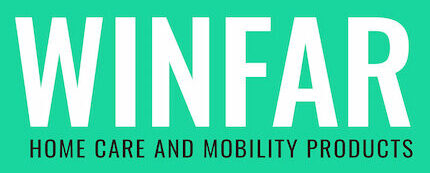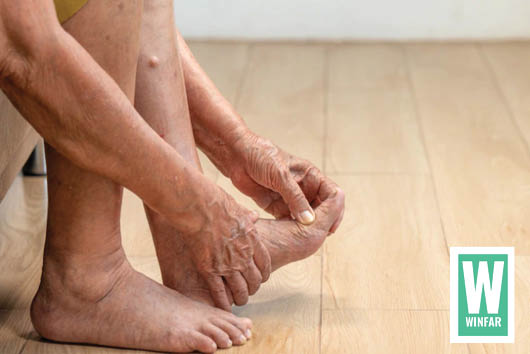Swollen ankles and legs in seniors affect safety and quality of life
Many older adults are affected by swollen ankles and legs. Which can make moving around more difficult, increase fall risk, and make the lower body feel heavy and uncomfortable.
This article will address the causes of swollen ankles and legs, exercises that will help reduce swelling, what to do before starting any exercises, and general lifestyle changes that can help.
Causes of swollen ankles in seniors
Oedema, is the swelling of the ankles, lower legs, and feet swell, and is common in older adults.Often the result of long periods of immobility, especially from sitting or standing in one place for too long, where water naturally gets pulled down into your legs and feet.
A weakening in the valves of the veins in the legs which leads to varicose veins can also lead to a buildup of fluid in the legs. Persons already struggling with mobility impairments and pregnant women are the most prone. But allergic reactions, medications, heat, and excessive consumption of foods with too much salt are common contributing factors. More seriously though…Oedema can also be a sign of a more serious underlying health condition.
Oedema can be caused by a variety of different issues including:
- Congestive heart failure and other heart conditions
- Chronic kidney disease
- Vascular conditions
- Rheumatoid arthritis
- After surgery, when the body is healing
- Inactive or sedentary lifestyle
There are more than 100 conditions that can cause swollen ankles in elderly people including heart failure, kidney disease, gout, and arthritis.
So, although swollen ankles are common in older people, never assume!
Be cautious with ankle swelling.
Do not self-diagnose.
Always have a medical professional determine the cause. Once the cause is known you can then make an informed and intelligent decision regarding how to treat the underlying condition, not just the symptom.
If the swelling occurs on one side of the body only, contact a doctor immediately. It could be deep vein thrombosis (a blood clot), which would need immediate medical treatment.
Lifestyle changes that can reduce swelling in ankles, legs, and feet
There are some things you can do at home yourself to reduce the swelling:
- Wear comfortable, supportive shoes, that aren’t too tight.
- Elevate the legs to allow gravity to help with circulation. Put a pillow under your legs when you are lying down or sitting for prolonged periods.
- Wearing compression socks or compression stockings. Support stockings put pressure on your legs to keep fluid from collecting in your legs and ankles. These may need to be specially measured and may require a prescription. So, always ask your doctor first before purchasing support stockings.
- Staying hydrated – it may sound counterintuitive, but dehydration can actually cause the body to retain more fluids.
- Eat more magnesium-rich foods like nuts, seeds, legumes, whole grains, and leafy greens.
- Limit your intake of salt and carbohydrates. Salt can worsen edema by promoting fluid retention
- Keep moving. Sitting or standing in one place for too long can increase swelling. Even moving knees and flexing ankles can help.
- Epsom salt baths (not scientifically proven, but many people say it’s effective)
Call your doctor immediately if you have any pain, redness, or heat in a swollen area
How simple home exercises help reduce swelling in legs and ankles
We found some simple home exercises that basically work against gravity and help the body pump fluids up from the feet and back into the trunk (center area) of the body. Once the fluid is in the upper body, it can be processed by the kidneys and eliminated in urine.
NB: What to do before starting exercises to get rid of swollen ankles
Before you start doing any exercises for swollen ankles or legs, it’s essential you first check in with your doctor, to find the underlying cause, and get their approval to exercise the area.
Moving fluid out of the legs and into the center of the body to be eliminated could put extra stress on their body, especially for people with heart or kidney conditions. For example, it might be dangerous to reduce swelling in the legs with exercise if that makes a heart condition worse. The goal is to safely improve overall health and comfort.
3 simple home exercises for swollen legs and ankles
Famous Physical Therapists Bob Schrupp and Brad Heineck demonstrate and explain how to do 3 simple home exercises that relieve swelling in legs and ankles.
As with any exercise, it’s always best to start slowly and increase over time to prevent injuries or discomfort. With your doctors approval.
Exercise 1: Ankle pumps (1:28 in video)
- Lie down and elevate feet.
- Moving only the feet, point toes up toward the head and then point toes down away from head.
- Go back and forth and aim for 30 repetitions, 3 times a day.
It’s best to do this exercise while lying down, but it can also be done while seated. To make them a little more effective while seated, use a stool to elevate the feet.
OR Another senior-friendly alternative (2:48 in video) is to tap the toes like tapping along to a song. It might even be fun to play some toe-tapping music to make it more fun.
Exercise 2: Butt squeezes (3:17 min in video)
- While sitting or lying down, tighten or squeeze and unsqueeze your glutes (butt muscles)
- Go slowly and try to hold the squeeze for a few seconds, then release and relax for a few seconds before the next squeeze.
- Breathe slowly and deeply.
- Aim for 10 of these squeezes, 3 times a day.
Exercise 3: Single knee to chest (5:09 min in video)
- While lying down, bring one knee up to the chest and then return the leg to the flat position. Keep the other leg either flat or bent with the foot on the bed to take pressure off the back.
- After finishing the exercises with one leg, switch to the alternate leg.
- Aim for 10 repetitions per side, 3 times a day, but use your judgement to see what works best for your older adult.
SOURCE: https://dailycaring.com/3-simple-exercises-for-swollen-legs-and-ankles-in-seniors-video/
DISCLAIMER: This website does not provide medical advice. This information, including text, graphics, images, and other material contained on this website is for information purposes only. No material on this site is intended to be a substitute for professional medical advice, diagnosis, or treatment. Always seek the advice of your physician or other qualified health care provider with any questions you may have regarding a medical condition or treatment before undertaking a new health regime, and never disregard professional medical advice or delay in seeking it because of something you have read on this website.

